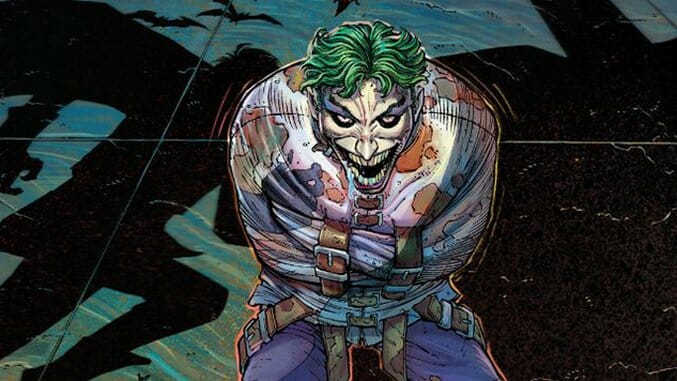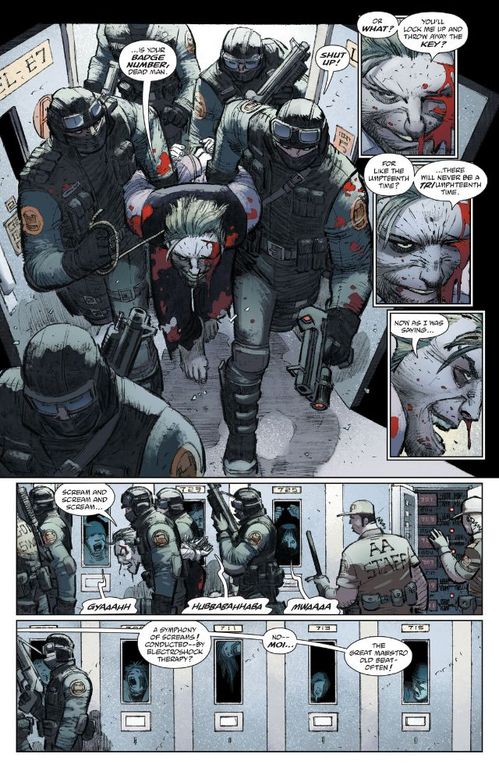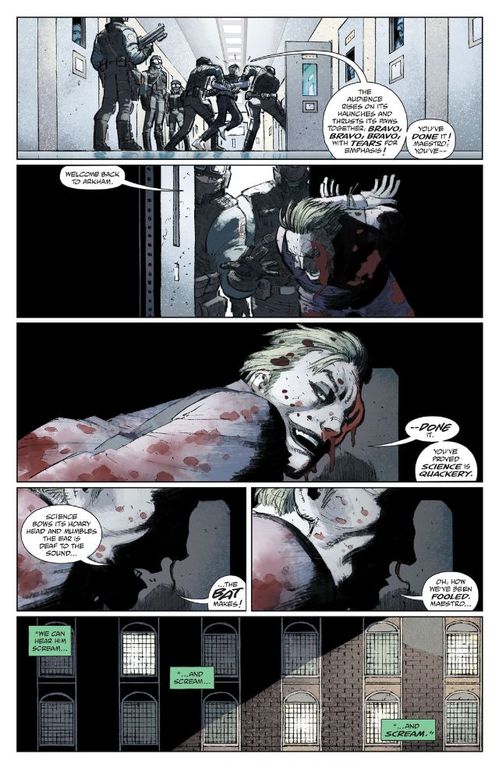Frank Miller Just Did the Unthinkable: He Wrote a Mundane Batman Story in Dark Knight: The Last Crusade
Comics Features Batman
Writers: Frank Miller, Brian Azzarello
Artist: John Romita Jr.
Colorist: Peter Steigerwald
Something went horribly wrong with The Dark Knight Returns: The Last Crusade. You don’t need to read it to know this.
The one-shot arrives in your local comic shop five months later and several pages shorter than originally scheduled. That level of tardiness never bodes well, but TLC doesn’t scan as rushed or compromised by some arcane squabbling between writer and editor. The supposed Dark Knight Returns prequel doesn’t host any event that could be described as asinine or contrived. Jason Todd never announces, “My planet needs me!” before flying off into the cosmos and exploding in space. An inexplicable scenario such as that would’ve embarrassed writers Frank Miller and Brian Azzarello and artist John Romita Jr. while driving longtime Dark Knight enthusiasts livid with hate, and that wouldn’t have been so bad. The disappointing reading experience would’ve been worth suffering through, if only for the deliciously entertaining and inevitable Twitter aneurysm.
Instead, with TLC, the most polarizing, controversial and possibly important Batman writer of the 20th century’s second half took his iteration of the Caped Crusader to a place we never, ever thought Frank Miller was capable of going….
He made a boring Batman comic. And maybe worse yet, he exploited the Joker for misleading advertising.
Are you truly hell-bent on exchanging $7 for a retelling of one of the saddest keystone events in Batman’s mythology, brought to us by the same two guys who redefined Daredevil’s origin with The Man Without Fear?
In that case, Spoilers Ahoy, we strongly advise against picking up The Last Crusade. Instead of a rejiggered Death In The Family that spins the infamous death of Robin in a new direction, Miller, Azzarello and Romita present a boilerplate Gotham crime yarn in which the Dynamic Duo stop Poison Ivy’s evil scheme to seduce rich dudes. And Batman gripes quite a bit about how he’s getting old and feeble. Jason Todd’s demise gets tacked onto the final page, with all the import of a letters to the editor section.
John Romita Jr. said he only did a deep read of 1986’ DKR for the first time this year. Back in the ‘80s, Miller’s pictures engrossed and enchanted a young Romita to the extent that he couldn’t pay much mind to dialogue bubbles. Oddly enough, his old approach to consuming DKR is also the best way to absorb TLC. Batman books of recent years tend to present the Joker more-or-less as a horror movie monster, which is perfectly fine and well. But with TLC, Romita Jr. takes Mr. J down the serial killer route. This Joker’s not a seething Dracula/Pennywise hybrid, but you will feel suddenly and strangely uncomfortable when he hands you the keys to your room at the Bates Motel. Sadly, this lower-key Clown Prince of Crime spends most of the comic planning an escape from Arkham, thereby wasting limitless possibilities…
Keep in mind, this story occurs in the Earth-31 compartment of the DC Multiverse—where The Dark Knight Returns, The Dark Knight Strikes Back and the current The Dark Knight III all take place. In this world, unexpected character moments have occurred. A bitter, jealous Dick Grayson volunteers for Lex Luthor’s Nathaniel Essex-style genetic experiments and transforms into the new Joker. While disguised as a baglady, Batman battles a topless female bodybuilder whose nipples are barely concealed with paint-on swastikas. Jimmy Olsen outs the president of the United States as a hologram. Barbara Gordon screams the F-word and we all heard it because somebody forgot to bleep it out.
Earth-31 is a place where that which is bonkers, even by superhero standards, is commonplace. Objectively bad stories are permissible, perhaps sadly necessary, in the DCU as overseen by Frank Miller. However, generic, milquetoast Batman adventures have no place in Miller’s Dark Knight world.

Dark Knight Returns: The Last Crusade Interior Art by John Romita Jr. and Peter Steigerwald
Oddly enough, judging only from his output under the DK banner this year, Brian Azzarello understands this better than Miller.
After only four relentlessly delayed issues, the primarily Azzarello-helmed (and Miller co-credited) Dark Knight III: The Master Race has plenty of problems beyond its chronic lateness. (Per authorship ambiguity, Miller said, “It is in Brian Azzarello’s hands right now,” during an interview with Newsarama.) The series relies too heavily on its comic-within-a-comic gimmick. Its first issue—which briefly felt like a godsend for anyone hoping for a story in the vein of the inaugural DKR saga—unfolds in Gotham’s violent urban squalor, and sets up Carrie Kelley, Commissioner Ellen Yindel and a possibly deceased Bruce Wayne at the center of the primary storyline.
In subsequent entries, a Kryptonite suicide cult shows up, bringing the bright pastel palette and abundance of inconsistently realized Justice Leaguers of The Dark Knight Strikes Again along with them.
Before the story lost interest in them, Wayne and Kelley emerged from a long period of hiding and resumed their usual crime-fighting practices. Mere days later, Ray Palmer unshrunk city-in-a-bottle Kandor’s citizenry, oblivious to the poorly conceived ISIS metaphor that had overtaken its populace. As convenient timing goes, that’s a whopper of a coincidence, isn’t it?
Let’s assume the writers intended the Kandor cult as a topical swing at ISIS, or any other form of militant religious extremism. A legion of brainwashed Kryptonians works as a metaphor for a gang of Middle Eastern militant equivalents almost as accurately as mutants stand for real-world oppressed minorities in the Marvel Universe. Which is to say, they don’t.
In The Master Race, Superman first appears frozen and inanimate for a yet-to-be-explained reason. Upon his liberation and awakening, the Man of Steel is promptly dispatched by his daughter, Supergirl, and the Kandorians. For at least the third time in Dark Knight continuity, Earth-31’s most powerful and wholesome hero is neutralized, humiliated and trounced. Meanwhile, Ray Palmer gets written as a clever, righteous kicker of asses.
So where does that leave Azzarello’s addition to the Dark Knight timeline?
Questionable story choices? Check. Substantial delays in print schedule? Check. Dubious right-wing political allegory? Check. Easily beaten-up Superman? Check. Hit-or-miss artwork, with visual low points rationalized by defenders as bad on purpose? Check.

Dark Knight Returns: The Last Crusade Interior Art by John Romita Jr. and Peter Steigerwald
Only halfway to the finish line, Azzarello has fulfilled many requirements for a traditional Frank Miller Dark Knight story. Stacked up next to TLC, which Miller is “much more involved” with, Azzarello’s Frank Miller impression feels more like the real deal than Miller himself.
![]()
At the conclusion of DC Universe: Rebirth, Batman finds The Comedian’s happy face pin buried in the Batcave for some reason, prompting outcries of blasphemy from purist fans. Alan Moore resents DC (and everyone else, for that matter) too much to write any more Watchmen stories. But if mucking around with Rorschach, Dr. Manhattan and the rest of the gang is a terrible idea, Moore’s lack of involvement isn’t the main reason.
Based on what’s transpired with the other groundbreaking grimdark DC property from the ‘80s, we know Frank Miller’s direct involvement with The Dark Knight doesn’t guarantee the same caliber of work as his initial foray. He didn’t invent Batman, and has stated he feels zero sense of ownership over the character, but he did invent the DK world, and thus played an indispensable role in framing Batman for a couple of generations. It was important that he did that. But if a DK comic like The Master Race can leapfrog off Miller’s legacy while retaining his beats, maybe the creator’s greatest modern contribution is simply his influence.
